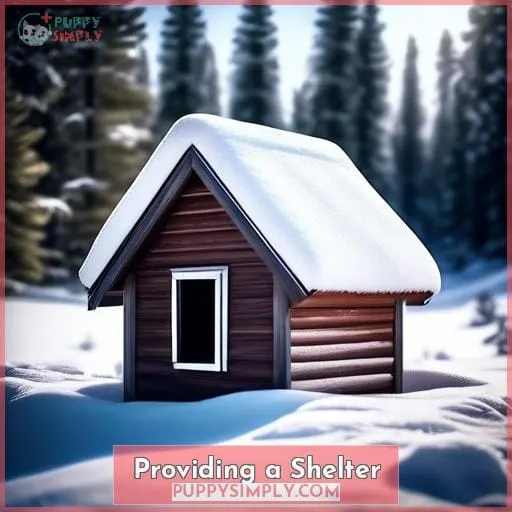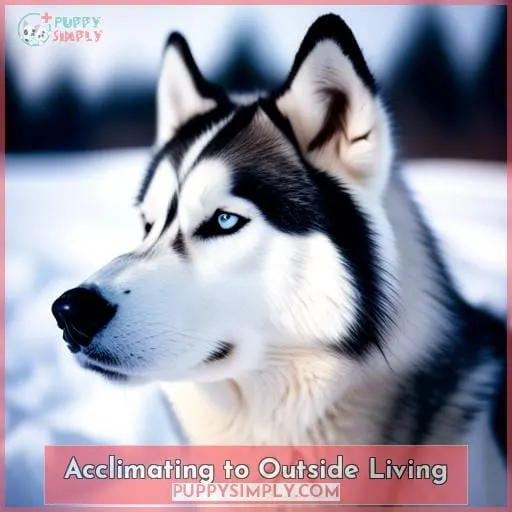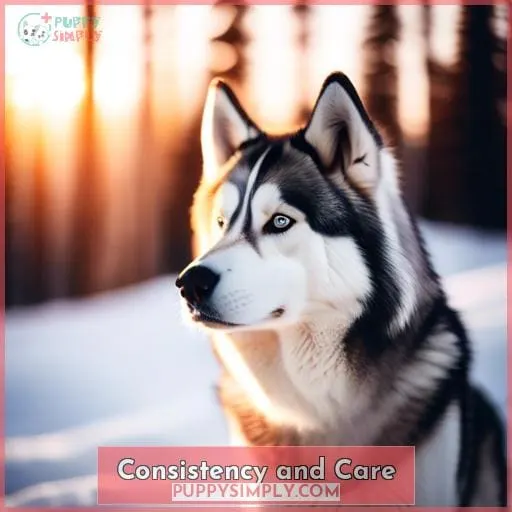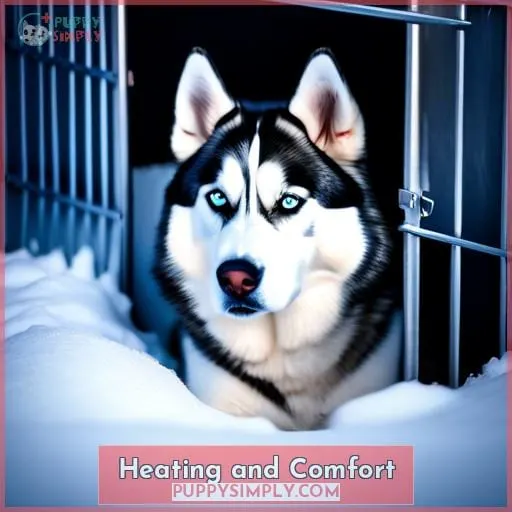This site is supported by our readers. We may earn a commission, at no cost to you, if you purchase through links.
 Think you’re safe from hypothermia out on that walk with your Husky? Think again.
Think you’re safe from hypothermia out on that walk with your Husky? Think again.
Huskies are a breed of dog that can withstand the coldest of climates. But even they need a little help from their humans to stay warm and healthy.
If you’re thinking about getting a Husky, or if you already have one, read on for some tips on how to keep your furry friend safe and sound in the cold weather.
Table Of Contents
- Key Takeaways
- Husky Outdoor Living Suitability
- Providing a Shelter
- Acclimating to Outside Living
- Developing a Thick Coat
- Consistency and Care
- Kennel Design
- Heating and Comfort
- Outdoor Dog Considerations
- Frequently Asked Questions (FAQs)
- How can I prevent my husky from barking excessively while it’s outside?
- What are some ways to provide mental stimulation for my husky while it’s outside?
- How can I ensure that my husky has a safe and secure outdoor space?
- What are some common health problems that huskies may face when living outdoors, and how can I prevent them?
- How can I make sure my husky is getting enough exercise and socialization while living outdoors?
- Conclusion
Key Takeaways
- Huskies are well-adapted to cold climates and can endure temperatures as low as -40 degrees Fahrenheit.
- Provide a suitable shelter with ample space, protection from the weather, and insulation.
- Gradually acclimate Huskies to outdoor living, starting with short periods and increasing the duration as they adjust.
- Develop a thick coat by acclimating Huskies to cooler temperatures, brushing regularly, avoiding frequent bathing, and providing a high-protein diet.
Husky Outdoor Living Suitability
When it comes to cold climates, you’ll find Huskies are perfectly adapted to living outdoors.
Their double coats provide exceptional insulation, protecting them from harsh elements.
These resilient canines can endure temperatures as low as -40 degrees Fahrenheit, making them ideal for outdoor living in frigid regions.
However, providing adequate shelter and care is crucial to ensure their well-being and prevent any safety concerns.
Huskies thrive in the outdoors, but responsible ownership demands attention to their needs, including proper shelter, nutrition, and regular veterinary checkups.
Embracing their natural hardiness doesn’t negate the importance of responsible pet ownership.
Providing a Shelter
As we delve deeper into the world of outdoor living for Siberian Huskies, it’s crucial to address the question of providing a suitable shelter.
This protective haven serves as their sanctuary, shielding them from the harsh elements and ensuring their comfort and well-being.
Let’s explore some key considerations for creating an ideal shelter:
-
Size Matters: Select a shelter that offers ample space for your Husky to move around comfortably, curl up for a cozy nap, and stretch out without feeling cramped.
-
Strategic Placement: Choose a location for the shelter that provides protection from strong winds, rain, and direct sunlight. Ensure it’s not in a low-lying area where water can accumulate.
-
Dry and Insulated: Keep your Husky’s shelter dry and well-insulated to maintain warmth. Use straw as bedding and replace it regularly to prevent moisture buildup. Consider adding insulation materials to the walls and roof for extra coziness.
Acclimating to Outside Living
Gradually exposing your Husky to the outdoors will help them adapt to a life spent outside.
Begin by taking them out for short periods during the day, gradually increasing the duration as they become more comfortable. This cold weather training will help them acclimate to the climate and develop a thicker coat.
To ensure a smooth transition, start by letting your Husky spend a few hours outside each day, gradually increasing the time as they adjust.
Provide them with plenty of outdoor socialization and exercise to keep them mentally stimulated and physically active.
Keep an eye on your Husky’s coat and condition to ensure they’re healthy and comfortable. If you notice any signs of discomfort or distress, bring them inside immediately.
| Acclimation Phase | Duration | Activities |
|---|---|---|
| Initial Adaptation | 1-2 weeks | Short outdoor sessions, supervised play |
| Gradual Increase | 2-4 weeks | Longer outdoor periods, socialization |
| Overnight Stays | 4-6 weeks | Start leaving them outside for a few hours at night |
| Full-Time Outdoor Living | 6+ weeks | Monitor closely, provide shelter and warmth |
Developing a Thick Coat
Let your husky acclimate to cooler temperatures by putting it outdoors during summer evenings.
Begin in the late spring with short periods and gradually increase the time spent outdoors.
This helps its coat adapt to cooler nights and develop a thick, insulating layer for winter.
Brush your husky regularly to remove dead hair and stimulate new growth.
This promotes coat thickness and health.
Avoid bathing your husky too often during winter, as this can strip its coat of natural oils and make it less effective at insulation.
Provide your husky with a high-protein diet to support coat growth and overall health.
Offer frozen dog treats and water to keep your husky hydrated while preventing dehydration.
Consistency and Care
To maintain a husky’s coat and health, it’s crucial to provide consistent living conditions.
Avoid bringing your husky indoors and then putting it back outside, as this can disrupt temperature regulation.
Ensure your husky has an adequate food supply and access to water at all times.
Feed your husky a high protein, high energy diet to maintain metabolism and warmth.
Regular exercise and mental stimulation are essential for your husky’s well-being.
Provide opportunities for play, interaction with other dogs and people, and training sessions.
Regular veterinary checkups are vital to ensure your husky is healthy and comfortable.
Your vet can monitor your husky’s coat and condition, and provide guidance on nutrition and preventive care.
Huskies need consistent routines and familiar surroundings to thrive.
Providing a safe and comfortable outdoor space with adequate shelter, bedding, and protection from the elements is essential.
It’s crucial to understand local laws and regulations regarding outdoor dog housing and ensure you’re compliant.
Kennel Design
For your husky’s kennel, you’ll want a well-constructed structure that gives them options.
Consider a two-room kennel with a smaller, warmer area for sleeping and a larger space for playing and moving around.
To keep your furry friend cozy, insulate the kennel with straw or blankets.
Ensure proper ventilation to prevent overheating.
If you live in an extremely cold climate, you might want to consider adding a heating source like a self-heating pad or a thick vet bed.
Heating and Comfort
With your husky’s kennel designed for comfort, you can now consider heating and comfort options.
Generally, huskies don’t need additional heating in the UK.
However, if you’re concerned about your husky’s warmth, there are several options available.
Kennel insulation can help trap their body heat, while heated dog houses and heated water bowls can provide extra warmth.
Self-heating pads and thick vet beds can also help insulate your husky and keep them cozy.
Avoid overcrowding in kennels to ensure adequate space and comfort.
Monitor your husky for signs of discomfort or distress, adjusting their living arrangements as needed.
Outdoor Dog Considerations
As you contemplate whether to keep your Husky outdoors, consider:
- The dog’s preference for the outdoors.
- The need to provide access to fresh water and food.
- The importance of exercise and mental stimulation.
Outdoor Shelter Options
When keeping a Husky outdoors, assess your shelter options:
- Consider an insulated kennel over an igloo; the latter lacks ventilation and can overheat in summer.
- Ensure the kennel is well-built and offers choices for your dog.
Provide thick straw bedding to insulate against the cold and keep moisture away from your dog’s body.
Consider a heated water bowl to prevent freezing and dehydration.
Acclimating to Outdoors
Start slowly by leaving your husky outdoors for a few hours each day.
Gradually increase the time spent outside to help your husky acclimate to the cold.
During this training, focus on three key aspects:
- Mental stimulation
- Vocalization management
- Coat maintenance
Engage your husky in outdoor activities to prevent boredom.
Teach your husky to minimize excessive barking or howling to respect your neighbors.
Regularly brush your husky’s coat to maintain its insulating properties.
With patience and consistency, your husky will adapt to outdoor living and thrive in cold weather.
Kennel Design Choices
- When keeping your Husky outdoors, consider a few kennel design choices.
- Consider an insulated kennel to protect your dog from the elements.
- Ensure adequate ventilation to prevent overheating in warmer months.
- Choose a kennel size that allows your Husky to move around comfortably and have separate areas for sleeping and playing.
- Consider heating options like self-heating pads or thick vet beds for extra warmth during colder nights.
Frequently Asked Questions (FAQs)
How can I prevent my husky from barking excessively while it’s outside?
To prevent excessive barking:
- Ensure your husky has ample space to roam and explore.
- Provide engaging toys to occupy their attention.
- Accustom them to outdoor living gradually:
- Start with short periods.
- Progressively extend their time outside.
What are some ways to provide mental stimulation for my husky while it’s outside?
Engage your husky’s clever mind with outdoor challenges:
- Obstacle courses
- Treasure hunts
- Interactive toys
These activities keep boredom at bay and stimulate its natural instincts.
How can I ensure that my husky has a safe and secure outdoor space?
Craft a safe haven for your husky:
- Secure the perimeter to prevent escapes.
- Provide ample space to roam and explore.
- Install a sturdy shelter with insulation and ventilation.
What are some common health problems that huskies may face when living outdoors, and how can I prevent them?
Huskies outdoors? Brace yourself for a battle against frostbite, hypothermia, and pneumonia.
Ensure shelter, warmth, and regular checkups to keep your furry friend thriving in the wild.
How can I make sure my husky is getting enough exercise and socialization while living outdoors?
Ensure your husky’s outdoor living space provides opportunities for exercise and socialization.
Create a secure area for play and interaction.
Regularly schedule outdoor activities and walks to keep your husky engaged and fulfilled.
Conclusion
Your Siberian Husky, a true emblem of perseverance and resilience, can flourish outdoors, embracing the frigid embrace of winter.
By providing a sanctuary of warmth, a haven from the elements, and a routine that nurtures their inherent strengths, you create an environment where your Husky not only survives but thrives, living up to their ancestral legacy of enduring the harshest of conditions.
Huskies can live outside, but they need the right care and environment to stay healthy and happy.














